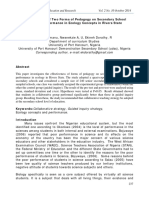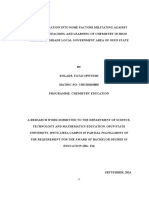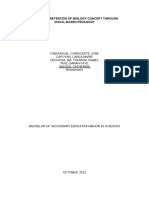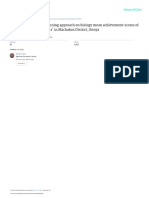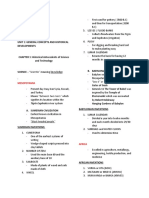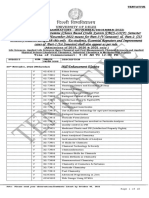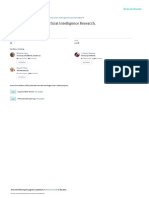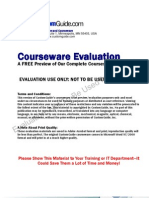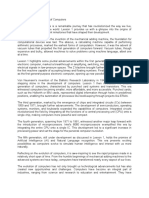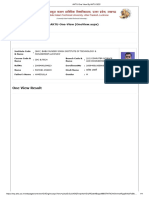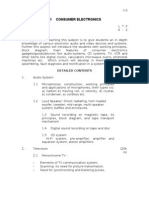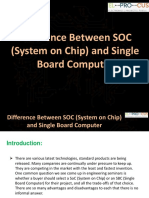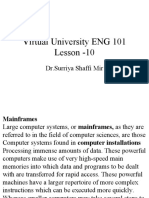International Journal of Biology Education
Vol. 3, Issue 2, May 2014
© International Journal of Biology Education, 2014 www.ijobed.com
Integrating computer technology in the teaching of Biology
Yassanne Garraway-Lashley
University of Guyana
, Faculty of Education and Humanities, Berbice Campus, Guyana, South America, E-mail: sanne_621@yahoo.com
Abstract
Over the past decade, the number of students who gained satisfactory passes at the Caribbean Secondary Education Certificate (CSEC) in Biology in Guyana has been few. This poor performance may be attributed to the traditional method of teaching that was used to teach Biology. This study therefore ascertained if the integration of computer technology into the teaching of Biology would e
nhance students’ academic performance. The study was guided
by a null research hypothesis. Hence, the related literature reviewed for this study showed
that integrating computer technology into the teaching of Biology can enhance students’
academic performance in the subject. A quasi-experimental, pre-test, post-test, non- equivalent control group research design was used for the study. The study used two intact grade 10 classes. One class was assigned the experimental group and the other class was assigned the control group through a simple coin toss. The experimental group was taught Biology using computer technology, while the control group was taught the same topic using the traditional method of teaching. A 20-item multiple-choice Biology achievement test was prepared by the researcher and was used for both the pre-test and post-test. Face and content validation of the instrument was achieved through the contributions from two grade 11 Biology teachers and a measurement and evaluation specialist from the University of Guyana. A reliability coefficient of 0.75 was obtained using Pearson product moment coefficient after a pilot test of the instrument. Data collected were analysed using mean, standard deviation, and t-test. The results of the study showed that there was a significant difference between the academic performance of students in Biology who were exposed to computer technology and those exposed to the traditional method of teaching. It was therefore recommended that computer technology be integrated into the teaching of Biology
to enhance students’ academic performance.
Key words:
computer, technology, academic performance

Integrating computer technology 14
Introduction
and background
Biology is the study of life. It entails what life needs to survive, what makes life possible and
how life forms interact with each other. Ministry of Education’s Science and Technology
strategic plan for Guyana 2008 to 2012, developed by Goolsaran in 2008, states that the study of Biology allows students to become aware of the presence and effects of the forces of nature in their everyday lives, and see themselves empowered to take responsibility for the care and protection of the environment specifically, and the earth in general. Biology therefore plays an important role in how humans interact with the biotic and abiotic components of their environment. This interaction is vital to the survival and sustenance of all living organisms on the planet. Thus, Biology is an imperative area of study, and as such, it is emphasized in the curricula of the Primary and Secondary schools in Guyana. It is part of the integrated or general science curriculum which is taught at the primary and junior secondary school levels. In the senior secondary schools, it is taught as a single subject and offered to those students who intend to pursue disciplines such as Medicine, Nursing, Dentistry and other areas in the natural sciences.
A comprehensive look at students’ performance in Biology has revealed that students’
performance in the subject area has been quite discouraging. Studies showed that the performance in Biology among students at senior secondary schools in Nigeria were poor (West African Examinations Council (WAEC), 2008, 2009, 2010&2011; Almed, 2008 cited in Yusuf & Afolabi, 2010; Umoke & Nwafor, 2014). Leever (2010) pointed out that students in the United Kingdom were also performing poorly in Biology. In addition, the performance of students in Biology at Bruneian schools was the lowest among the sciences (Yong, 2009). This problem was also evident in the Caribbean Regions. Ogunkola and Fayomba (2009) claimed that the major challenge facing Science Education in the Caribbean was the underachievement in the science subjects among the secondary school students. Sweeny (2003) cited by Ogunkola and Fayomba (2009) noted that of particular concern in the Caribbean was the relatively low extent of Science Education, as suggested by the number of students who successfully pass the secondary level science examination. Sweeny (2003) further stated that a cursory review of Caribbean Secondary Education Certificate (CSEC) results in Biology, Physics, Chemistry and Integrated Science for the past ten years indicated that the pass rate had for most part fallen below 50 % (Table 1).
Table 1.
A summary of Biology (CSEC) results for the Caribbean from 2007-2011
Year Grade 1 Grade 2 Grade 3 Grade 4
Grade 5
Grade 6
2007 9.66 24.74 37.92 19.00 8.59 0.08 2008 15.81 27.02 34.43 15.68 6.99 0.06 2009 11.82 25.52 37.38 17.34 7.91 0.03 2010 11.04 26.13 37.97 17.48 7.34 0.04 2011 16.28 24.29 32.51 17.76 9.07 0.10
Source: Caribbean Examination Council (CXC) annual report, 2007- 2011.
Guyana was no exception in terms of poor performance in Biology. An analysis done by the National Centre for Educational Resource and Development (NCERD) from 2000- 2013
showed that students’ performance in Biology over the last decade was fair when compared to
International Journal of Biology Education
Vol. 3, Issue 2, May 2014
15
Chemistry and Physics; however, the number of students who gained grade1’s or 2’s at CSEC
in the subject area were few (Table 2).
Table 2.
A summary of Biology (CSEC) results in Guyana from 2000-2013
Year Grade 1(%) Grade 2 (%) Grade 3 (%)
2000 1.10 6.20 27.10 2001 1.70 8.90 30.60 2002 1.80 9.00 33.50 2003 2.70 16.00 34.10 2004 2.40 14.80 35.10 2005 9.30 16.60 32.30 2006 9.00 20.40 34.00 2007 4.80 19.30 38.80 2008 9.86 22.64 38.83 2009 6.69 22.03 39.53 2010 9.20 25.20 35.80 2011 9.00 22.00 38.00 2012 9.10 20.20 34.03 2013 9.34 22.62 32.84
Source: CXC analysis of results for Biology (2000-2010), NCERD
Several researchers have pointed out different reasons for students’ poor performance,
some of which are due to the abstractness of certain aspects of biology, lack of understanding
on the students’ part, and certain biological concepts and terminologies (Okeke &
Ochuba, 1986; Nzelum, 2010). Ibe
(2004) noted that these observed deterioration in students’
achievement in biology must have been contributed by the strategies of teaching biology (cited by Chinna & Dada, 2013). Hence, in many instances, it was observed that Biology was taught using the traditional method of teaching, where many concepts were taught and learnt in isolation. Students in these classes were passive and were asked to memorize and regurgitate information; resulting in them being bored and frustrated with their learning. As such, they were not able to recognise the importance of the subject to real life situations. Usman (2010) emphasized that the present mode of teaching biology in secondary
schools whereby teachers’ adopt only the lecture method does not in any way provide
for sequence of learning experiences. This may have led to the poor performance in the subject area. Hence, the quality of teaching which students were receiving has contributed to their decline interest and performance in science (Leever, 2010). It must also be noted that student achievement in any course of study is a function of instructions. Therefore, approaches to instruction must be considered a serious factor in science education (Umoke & Nwafor, 2014). As a result of the poor performance in Biology, educators are faced with the challenges
of improving students’ performance in the subject area. In their search for more innovative
instructional pedagogy, the use of computer and other forms of technology are being analysed for their impact on students
’ academic performance. Research showed that Technology can be
used to perpetuate old models of teaching and learning (New Horizon for Learning, 2005) and
Integrating computer technology 16
motivate students to achieve. Studies have also shown that technology used interactively with discussions and guidance can become a tool for the development of higher order thinking skills (Walker, 1998). Computer technology therefore, might provide students with the opportunities to actively explore Biology as an experimental subject instead of a descriptive one. This active participation in their learning might improve their performance in the subject area. It was against this background, the researcher sought to ascertain if the integration of computer technology into the teaching of Biology would impr
ove student’s academic performance.
Purpose
The study aimed at finding out if there was any significant difference between the performance of students in Biology who were exposed to computer technology and those exposed to the traditional method of teaching.
Research hypotheses.
The hypothesis for the study was as follows:
Ho1:
There is no significant difference between the performance of students who are exposed to computer technology and those exposed to the conventional method of teaching Biology.
Scope and Delimitation.
This study was carried out at Berbice Educational Institute using only two Grade ten classes. The control group was taught using the conventional method of teaching. A computer with CD/DVD Rom, LCD projector and computer stimulations were used to teach the experimental group to find out if the integration of computer technology in the teaching of Biology would enhance the academic performance of the students, which was measured by a teacher made achievement test.
Review of related Literature
Theoretical Framework
Schneider (2011) defined educational technology as “the ethical practice of facilitating learning
and improving performance by creating, using and managing appropriate technological
processes and resources” (p.1). It was further explained as an array of to
ols that might be proven
helpful in advancing students’ performance. Hence, the integration of educational technology
in the classroom is claimed to be based on three theories of learning, i.e. Behaviourism, Cognitivism, and Constructivism. Jean Piaget, a cognitivist, believed that learning should be a process rather than some
stable state or end process. Jermone Bruner, a critic of some of Piaget’s earliest work contended
that individuals form or construct much of what they learn and understand (Bruning & Schraw, 1995) as cited by Schunk (1996). However, both theorists have concluded that students are able to gain knowledge through active interactions with their learning. Like Piaget, Bruner advocated student cantered learning. They believed that many of the more traditional methods of teaching involved simply transferring information from the teacher to the child. Therefore,
the learner’s role is especially passive in such endeavours. In such a classroom, students simply
respond, receive, repeat or memorize information given by the teacher. At its best, Piaget claimed that such type of learning is incomplete and very short lived (Piaget, 1974, as cited by Schunk (1995).














